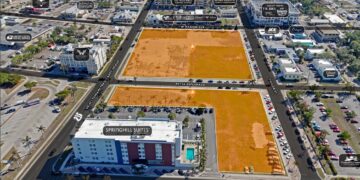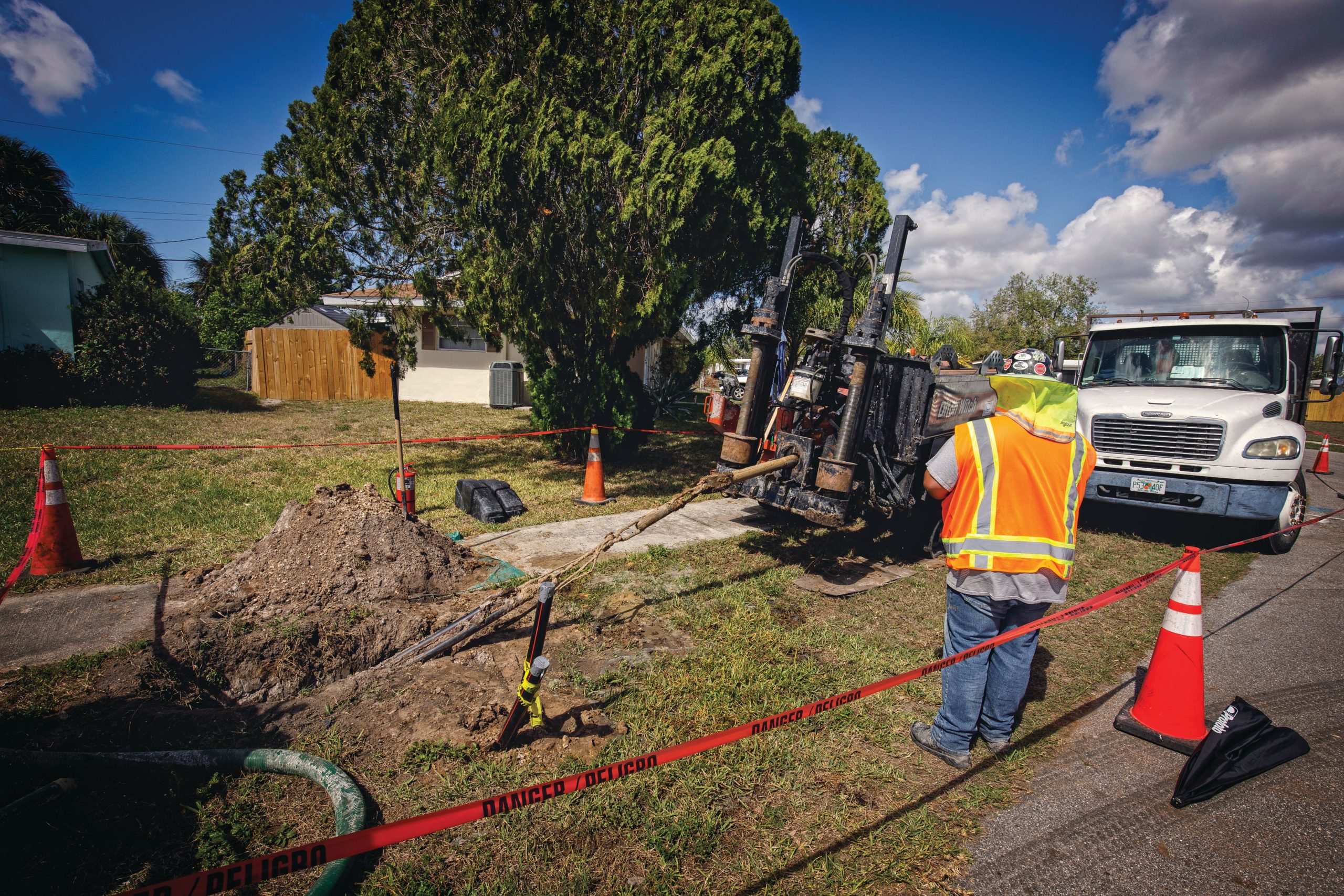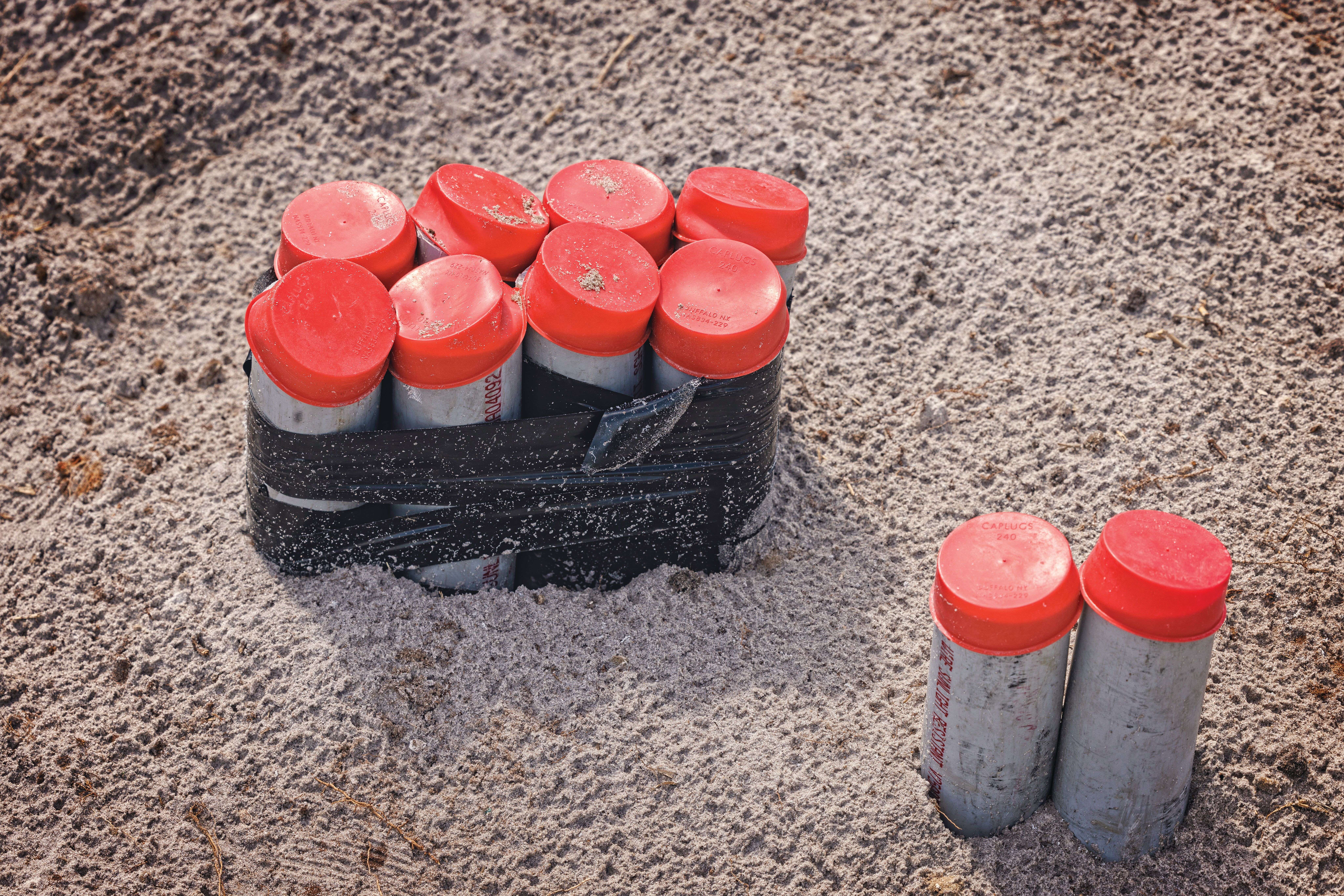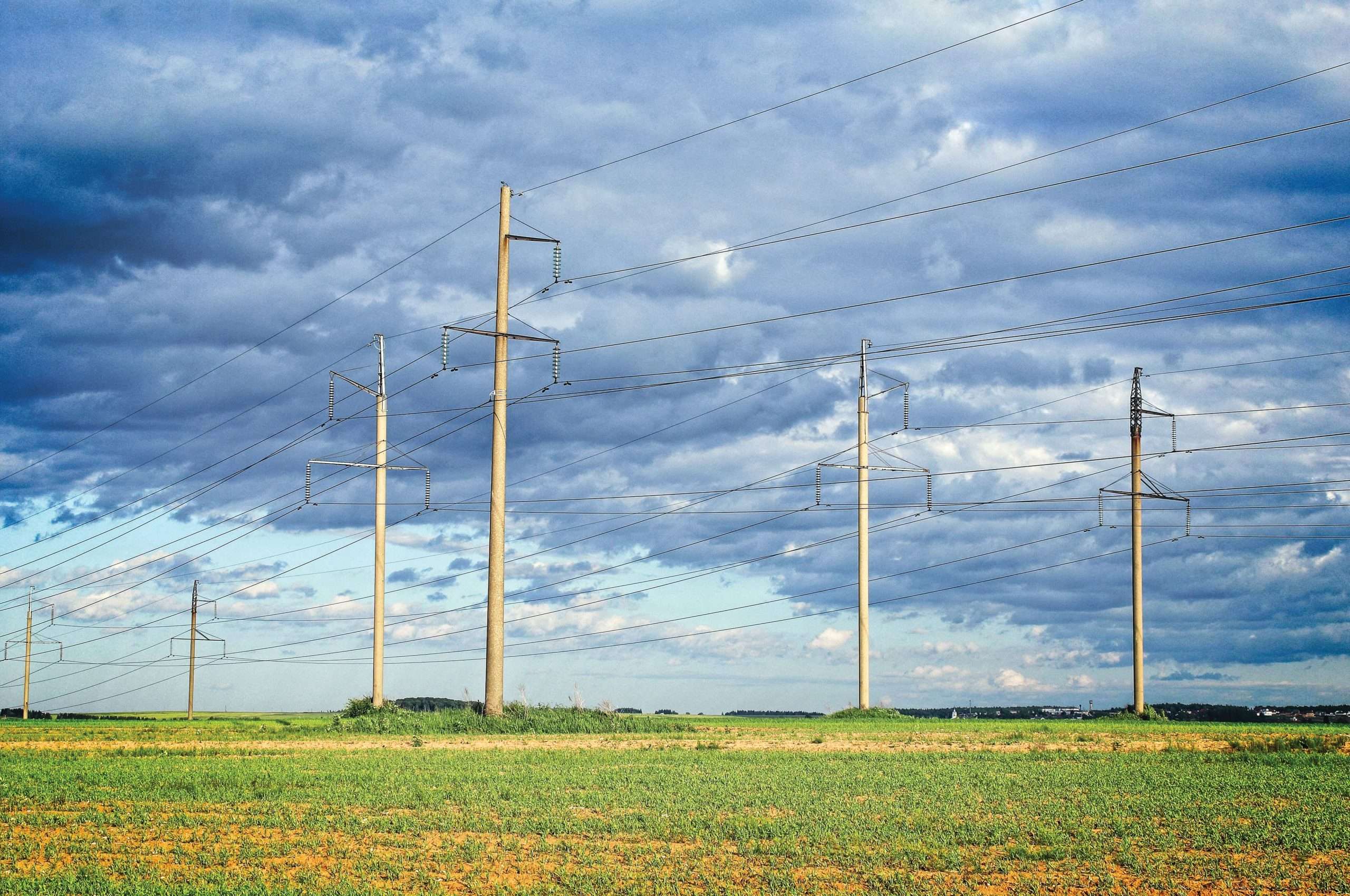The clamor of the earth mover begins. The diesel engine springs to life. And the operator of the Ditch Witch equipment, which looks like something out of the Mad Max universe, starts drilling into the ground, carving a space for flexible plastic piping to be inserted and dragged under the ground between the homes on Bragg, Hernando and Claude streets in a Port Charlotte community east of U.S. 41.
Most of these homes were built in the 1950s and ’60s; many appear to be showing their age. And they all have overhead power lines, which have been showing their age, too. But not for long. Those lines are in the process of being replaced and then removed.
Inside that underground plastic piping will flow electricity. Florida Power & Light, or FPL, Southwest Florida’s largest supplier of electricity, serves some 645,700 regional customers and 5.7 million households across the state. Through the end of 2021, FPL completed 13 undergrounding projects in Lee County and 25 in Collier County, said George Bennett, FPL senior communication specialist. Lee County Electric Cooperative, or LCEC, serves more than 221,000 households in Cape Coral, Sanibel and Captiva islands and parts of Everglades City, Marco Island, Lehigh Acres and North Fort Myers.
To different degrees, the region’s largest electricity companies have been rolling with the changes in technology. As hurricanes continue to batter Southwest Florida, the electric companies are moving more of their overhead neighborhood power lines underground.
PORT PLANS
The Port Charlotte project belongs to FPL. After the devastating hurricane seasons of 2004 and ’05 that included Hurricane Charley destroying much of Port Charlotte and Punta Gorda, FPL began a process of “hardening” its primary above-ground transmission lines. These are the big ones, the ones that lead from a power plant to a substation that then feeds the electricity to the above-ground—and more frequently, below-ground—neighborhood lines.
Although new communities have been making underground power lines a standard practice since the 1980s, FPL began retrofitting older communities from above- to below-ground power lines in earnest after Hurricane Irma tore through the region in 2017. That’s when FPL developed a formula for retrofitting communities such as the one in Port Charlotte, said Robert Gaddis, director of FPL’s Storm Secure Underground Program.
Two dollars of every FPL customer’s monthly power bill go toward the Storm Secure Underground Program. That means homeowners in Fort Myers, for example, are subsidizing the costs of the Port Charlotte project. And vice versa down the road, depending on where FPL is doing the upgrading.
“We have a plan installed with Florida’s Public Service Commission,” Gaddis says. “We have a prioritization system. There is a combination of factors. One is if they’ve had a major outage from a hurricane. The second one is the total number of outages they have had over the past 10 years. The third factor is the total number of outages related to vegetation. We take those three factors into prioritization. Anything we do in this program is going to be prioritized.”
Tom Ballinger works for Florida’s Public Service Commission as the director of its engineering division and helps coordinate projects with FPL. “The undergrounding of lines is part of the Florida plan of storm protection,” he says. “Not only undergrounding, but the strengthening of above-ground lines as well. It’s something the commission reviews every three years. We look at what the investments are and what they will be in future years.”
FPL’s hardening of transmission lines resulted from the commission and the state Legislature taking action. “That was the first round of hardening,” Ballinger says. “That came out of the commission and the Legislature. Building stronger poles, things of that nature.”
Matt Devitt, WINK-TV’s chief meteorologist, dug up the National Hurricane Center’s data, which showed hurricanes hitting Southwest Florida once every eight to 10 years. Ballinger said this trend held forth after 2004-05, which gave Southwest Florida time to harden its power lines and prepare for the next fierce storm.
“We were lucky that it gave us time off,” Ballinger says. “We could do a lot of improvements to the system. Irma affected most of the state, and it gave us a good chance to gather data. We were able to see the effects of the power line hardening. And that was when we also started this latest round of installing underground lines.”
Devitt hoped the trend would hold true after Irma devastated the region in 2017, as well. “Another interesting note is that despite 2020 and 2021 being some of the busiest years on record across the Atlantic and the country, Southwest Florida was minimally impacted,” Devitt says. “The reason I wanted to bring that up is because we can’t make a connection at this time that storms hitting Florida are accelerating.”
JUMPING THE LINE
Individual homeowners, new communities, private homeowner associations, private businesses or even non-gated, older communities can jump ahead of the priority line with FPL, Gaddis said. But they must pay all the expenses for the underground power lines.
LCEC does not have the “priority” formula FPL does. Instead, it will install underground lines for homeowners and neighborhoods willing to pay for them, said Karen Ryan, LCEC public relations director.
A 2006 study by the Edison Electric Institute found that burying overhead power lines cost about $1 million per mile, about 10 times what it costs to install overhead lines, she said.
Making the undergrounding of all lines a standard practice, the study showed, would result in rate increases of 80% to 125%. “Installing underground is best done as an area is being developed,” Ryan says. “This is less expensive than converting later from overhead to underground.”
An individual homeowner or business in an area full of above-ground power lines has little to gain by switching, both LCEC’s Ryan and FPL’s Gaddis said, because those below- and above-ground lines come from the same power source. But if an entire neighborhood of homeowners agrees to pay, it could lessen the length of future power outages.
“Sometimes we need easements,” Gaddis says. “We need agreements from the customers to put these lines underground. We need to really get the word out about the program.
“We start with sending letters, informing people that we’re starting on the work. It would start with us reaching out with a form letter to the home. We do have people go out to homes and knock on doors. We’ll have someone who will explain exactly what’s going on.”
Ballinger said communities need to buy into the concept for undergrounding future lines to work well. “Because it’s really just getting started, there will be some bumps in the road of getting people to buy in,” he says.
BUSINESSES MAKE DO
Bell Tower shopping center in Fort Myers and Mercato shopping center in North Naples are each located off U.S. 41, and each have luxury-oriented tenants. The two retail centers also each already have underground power lines.
Michael McLean, Mercato’s general manager, shared part of the center’s post-hurricane plan.
“After a hurricane or other power-loss event, it’s always our goal to reopen the center as quickly as possible when it is safe to do so,” he says. “The timeframe is determined by the businesses themselves. Some do have emergency power capabilities that would allow them to reopen more quickly. In the event of a power loss, Mercato would communicate with shoppers via our social media and the Mercato website.
“Mercato has had its services restored very quickly in the past. After Hurricane Irma, for example, Mercato was one of the first shopping centers in Collier County that regained power, with several of our retailers and restaurants opening within the first three days after the storm ended.”
At Bell Tower, General Manager Jim Brennan recommends that its tenants not operate without power.
“If we were to lose power due to a hurricane, we would need to work with FPL to have it reinstalled before reopening the center,” Brennan says. “FPL has been very responsive to Bell Tower in the past, and we have every confidence that they would work quickly to restore the center’s power in the event of an outage.”
While Bell Tower has underground power lines, the hotel across the street does not: They are above the ground at the Crowne Plaza hotel.
“We lost power during both Hurricane Charley and Irma,” said Jim Larken, the hotel’s general manager. “Fortunately, the hotel has a commercial generator that allows us to power most of our public areas and essential equipment like kitchen refrigeration and front desk property management systems. We operated through both Charley and Irma because of our having a generator, although it does not provide power to our guest rooms or the guest room A/C units. When we lose power, our staff initiates a checklist of procedures to help provide our guests with assistance and information to the best of our abilities.”
This includes setting up charging stations for cell phones, doing a limited menu at the restaurant and offering limited housekeeping if the power outage is prolonged.
“Personally, I would welcome having our power lines to the hotel underground, as I believe this would help prevent outages during severe storms,” Larkin says. “During both Charley and Irma, we witnessed where the lines went down, and we were without normal operating power for more than 72 hours.”
NEW COMMUNITIES GETTING AHEAD
At Babcock Ranch, the community with a planned buildout of about 20,000 residents off State Road 31, all the neighborhood power lines were installed below ground from the very beginning, said Syd Kitson, founder of the community and CEO of Kitson and Partners. Those neighborhood lines connect with a substation that’s powered during the day by an adjacent solar farm.
“It was never even contemplated that we would have above-ground wires,” Kitson says. His planned communities, going as far back as the mid-1980s in central New Jersey, always have had below-ground power lines, he said. “Aesthetically, not having those poles all over the place, it’s always been a huge benefit.”
Hurricane Irma in 2017 cut through Babcock Ranch, which had zero residents at the time but did have its downtown finished. “It was really interesting,” Kitson said. “For us, we learned a lot from Irma. The eye of the storm came right over Babcock. We had all these solar panels on top of the roofs here. We had the first 75 megawatts that had been built. Now we have 150 megawatts. We also have them on top of our roof in Founder’s Square in those buildings. What we learned was, even with Irma, we did not lose one solar panel. It tells you that when you build it right, there’s a very good chance that solar energy is going to be extremely reliable even during extreme weather. We looked at our infrastructure. It was a really good test run for us.”
THE BAD NEWS
Having underground power lines will not prevent a power outage during and after a major hurricane. “If the power goes out going to your neighborhood, there are still poles that have to bring the electricity to your neighborhood,” Kitson says, referencing the large above-ground lines that bring power to the buried lines.
There’s no way to build a system strong enough to protect against everything, because the giant transmission lines that run from the power plants to the substations would be cost-prohibitive to bury. “It’s very, very rare,” Gaddis says of having a major transmission line buried underground. “You have to run cold nitrogen through them to cool them off. Those come with a lot of maintenance. Transmission lines, 99.5% of them are overhead. Then we have the feeder lines. Those feeder lines, we have been hardening since 2006. The neighborhood lines, those are the ones closest to the customers.”
Those are the most difficult to maintain because there are so many of them. The biggest issue under normal circumstances is interference from vegetation growth. But because they can be put underground, they are being put underground. Slowly but surely.
“In 2018 through 2021, they were selecting individual neighborhood lines,” Gaddis says. “We were doing one neighborhood at a time. Now, we’ve changed that methodology. Now, we’ll select the entire feeder’s lines. And every neighborhood that is spun off that feeder, we’re doing them collectively. That makes things more efficient; we’re not having to move equipment across town all the time. We’re doing full communities instead of individual circuits.”
Phil Flood lives off McGregor Boulevard in Fort Myers, where his street had underground power lines installed in early 2021. “They were really good to work with,” Flood says of the FPL workers and contractors. “They gave us their cell numbers. They told me we could call them any day or any time. They did the entire street. They came to us and offered to do it. We all agreed. It seems to be worthwhile. It seems like it must be cost-effective. It will be interesting to see how many power outages we had before and how many after. The street behind us, they still have the above-ground power lines.”
THE FUTURE IS NOW
The model of one street with power lines below ground and the next street above ground won’t be the case moving forward with the new methodology, which is happening right now in that Port Charlotte neighborhood. As the Ditch Witch springs to life, Sergio Rendon, president of RIS Underground, supervises. His company, with between 70 and 80 employees and contracts with FPL, has been installing underground power lines for 11 years now. “You can drill in any direction you want,” Rendon says. “We can go as deep as we see fit.”
India Monahan is at the site, as well. As a project manager, she helps coordinate about 200 FPL employees and contractors as they work the various projects. This Port Charlotte project will convert about 200 homes, moving about five miles of wiring underground. Monahan said that most FPL interactions occur during the challenging times of restoring power, so it felt good to be serving communities and interacting with neighbors during the good times of burying power lines instead of the bad times following storms. “It’s a win for the customer,” Monahan says. “We’re giving them a more reliable service.”








